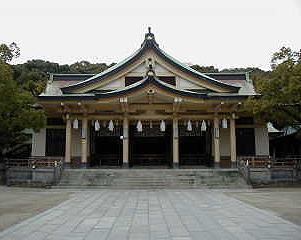
Minatogawa Jinja
There were two kinds of gunto in WWII: Commissioned Officers and Non-commissioned officers (including private). CO's sword was private and NCO's was public property. In early days, army resembled French style sabre and navy resembled England style. In Meiji 9th year, carrying sword in public place was forbidden and lots of smiths lost their jobs and even Tatara came to be closed. However, during subsequent wars between China and Russia, lots of swords came to be needed.Murata-blade or Kanaken-blade were developed and supplied to soliders during these wars. In early days, western style of sword was used but it was not good for Japanese. Sabre in one hand was not familiar with Japanese who uses both hands to grasp handle.
NCO's, cavalry's, and private's swords were produced by army as mass-production. In showa 6th, the Manchurian Incident broke out and lots of swords came to be needed. In showa 8th, to digest these requests, NTK (Nihonto Tanren Kai) was established in Yasukuni Jinja. Also, Tatara came to operate again and, with this motivation, many smiths began to make blades on a national scale, especially in Seki province. At this time, army selected "Rikugun Jumei Tosho" and began to supply good blades to their officers. Army reported their mounting type in Showa 9th, and navy reported their style in Showa 12th. In Kobe, Kikusui Tanto Kai in Minatogawa Jinja began to supply swords to high rank naval officers. Thus, gunto was made in various places by various people ranging from high qualified Yasukuni/Minatogawa smiths to private smiths.
During Pacific war, smiths couldn't meet the need of blades and they couldn't help making blades with less steps. Non-traditionally made blades such as less forging and the use of poor steel (Mantetsu) came to appear. These blades are so-called "Showato", which are widely known as poor-made blades. This made people remind that "Gunto=Poor-made".
However, Gunto is composed of "Real Nihonto" and "Practical military sword". Therefore, the concept and the point of view about Gunto should be reconsidered profoundly.
Reference
Takada Kouji "Gunto no motsu Meiroku"
Uchiyama Hiroshi "Nihon Gendaito Shoshi"
